Every pond is susceptible to the growth of weeds, and when these grow out of control, it can be a huge nuisance for pond owners. There are many different types of pond weeds, and this guide can help determine which weeds are present in your pond and help you create a proper treatment plan. After identifying the weeds below, fill out our form and we can send you a free, custom pond treatment plan! A chemical treatment plan might be needed to remediate the problems before using our all-natural products.
Floating Pond Weeds & Plants
Floating weeds and plants are most common in shallow ponds. In small amounts, some of these floating plants, such as water lilies and water hyacinths produce lovely flowers and can be quite beautiful. However, as the number of these floating plants begins to grow, they tend to cover the entire surface of your pond, which reduces the oxygen level in your pond, and can lead to fish kills. Some types of aquatic weeds and plants are more harmful and invasive than others.
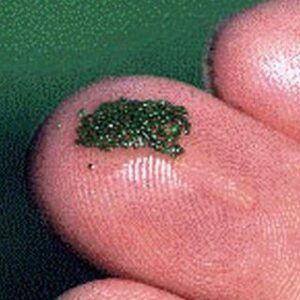
Watermeal
When it comes to floating pond weeds, duckweed and watermeal are two types that are difficult to control, unattractive and affect the quality of your pond water. Watermeal reproduction occurs rapidly, so if you notice these tiny green plants, which resemble grains of sand or cornmeal, you will want to take action very quickly.
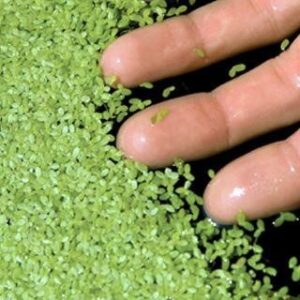
Duckweed
Duckweed is slightly larger, and it often is mistaken for algae, but algae have no root system where duckweed has a small, hair-like root hanging on its underside. Once it becomes established in your pond, it can quickly cover the entire surface of the water, cutting off oxygen to fish and other wildlife.
Submerged Pond Weeds
As the name suggests, these types of pond weeds are typically found underwater or just under the water surface. One of the most common is American pondweed, which has soft stems and oval-shaped leaves. Some leaves are submerged, while other leaves lay just at the surface of the water. There are many other varieties of pondweed, including curly-leaf pondweed, Illinois pondweed, Sago pondweed and more.
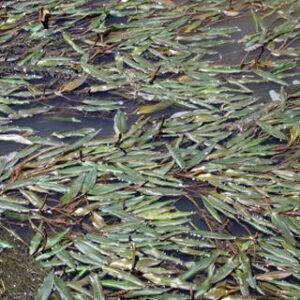
American Pondweed
There are a variety of milfoil plants that can grow in your pond, but Eurasian watermilfoil can be quite aggressive. The plants have distinctive feather-like leaves and sometimes it produces a reddish flower that will extend above the surface of your pond.
Because it is so invasive, Eurasian watermilfoil is a prohibited species, and it is illegal to import, purchase or transport this weed. There is also a similar plant, northern watermilfoil, which is considered a beneficial native plant. Here is a picture of Eurasian watermilfoil.
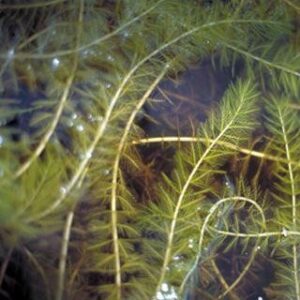
Eurasian Watermilfoil
One of the easiest ways to differentiate between Eurasian and northern watermilfoil is to gently lift a portion of the plant out of the water. If the leaves remain still or stiff, it probably is northern watermilfoil. If the leaves become limp, it is likely the Eurasian variety. Eurasian watermilfoil also has between 12 to 20 leaflet pairs per leaf, while the northern variety usually only has about 8-10 leaflet pairs.
Keep in mind, we are highlighting just a few types of pond weeds and there are many other submerged weeds, including naiads, coontails, elodea and hydrilla. Muskgrass, also known as Chara, is foul-smelling and while it looks like a pond weed or grass, it is actually a type of multi-cellular algae. It grows from the bottom of your pond, and quickly can grow out of control.
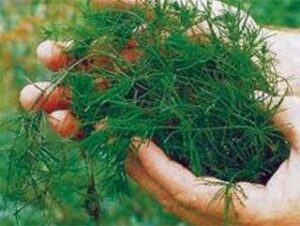
Muskgrass (Chara)
Emerged Pond Weeds
These tend to congregate near the shoreline and can grow quite tall, such as cattails and purple loosestrife or shoreline grass. Bulrushes also are a common issue around the shoreline of a pond.
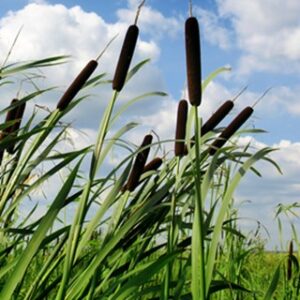
Cattails
White water lily is another type of emergent pond weed, and while a few of these lilies might look lovely on your pond, unmanaged lilies can cause problems. This hardy weed can propagate quickly and overtake your pond, outcompeting native plants that you want along your shoreline. Here’s a picture that demonstrates what can happen in these lilies are not kept under control.
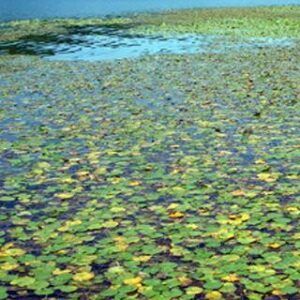
White Water Lily
You do want to have some plants around your shoreline. Beneficial plants prevent shoreline erosion and act as a barrier from runoff from your property. However, these emergent pond weeds tend to grow quickly and reduce the habitat for native beneficial plant life.
Pond Weed Management Tips
Pond weeds are quite common, and we have treatments that can kill many types of pond weeds. We recommend using these treatments before trying to remove the plants as plant removal can be tricky. If you remove the plant but leave fragments behind, these fragments will simply root and grow again.
Likewise, if you don’t carefully and gently remove the plant’s roots, the roots will simply regrow. If you do remove live weeds from your pond, it is important to remove the entire root system and then dispose of the weeds far away from the pond. Never dispose of aquatic weeds in an area where wind or rain could scatter the plants back into your pond.
Many aquatic plants can be placed into compost bins and then used later as compost for your garden or flower beds. Once they are composted, they can provide much-needed nutritional support to your garden plants and flowers. Otherwise, these plants should be transported to a waste facility away from any sources of water, such as streams, rivers and lakes.
To learn more about our chemical weed control options, head to our handy Weed Definitions page at https://healthyponds.com/weed-definitions/. Here you will find more pictures and links to treatment options for different types of pond weeds. You also can check out our short article on identifying pond weeds at https://healthyponds.com/guide-to-help-identify-pond-weeds/.


My Alabama freshwater pond has been totally taken over by a submerged aquatic weed. Looking at the photo’s my guess is Chara. This submerged plant is all over the bottom of my pond and the plant looks large (half a car size) like shrubs in yards! It almost looks like se3aweed that you get on your line when surf fishing for Pompino in the Gulf of Mexico. How can I verify what this aquatic plant is & what will KILL it (not treat it). My pond is 60 years old and we never had weeds in trhe pond until about 5 years ago. We have tried raking aand pulling it out bu. We have used Diquait, aquatic pellets aand other things etc. The pond is spring-fed and will have to have the gates closed to retain water. The weather without rain will be a must! It is about aa 5 acre pond. HELP HRLP
Would you be able to take a picuture of the weed so we can identify and then send you a treatment plan?
You can send the pictures to support@bioverse.com.
Thanks!